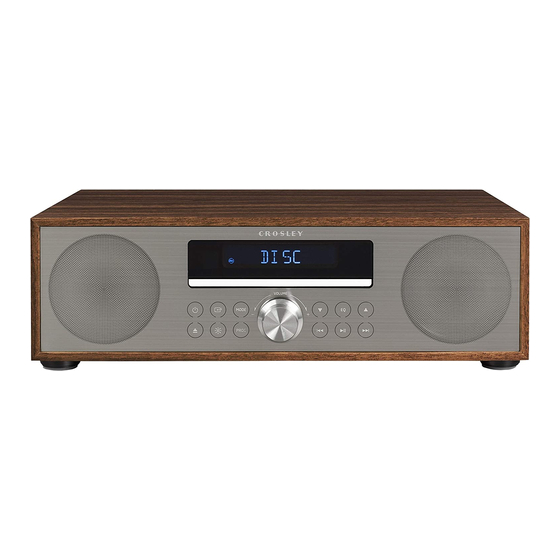
Summary of Contents for Crosley CR3501A
- Page 1 CR3501A Fleetwood Instruction Manual Questions, problems, missing parts? Before returning to the store, call Customer Service 8 a.m. – 6 p.m., EST, Monday – Friday 1-888-CROSLEY www.crosleyradio.com...
-
Page 2: Safety Instructions
English Safety Instructions Read and understand this entire manual before using this product. Keep these instructions for future reference. Do not use this product near water. This product should be operated only by the type of power source indicated on the marking label or in this instruction manual. Do not defeat the safety purpose of the polarized plug. -
Page 3: Specifications
Remote Control Power cord 3.5mm aux in cable FM Wire Antenna Please contact Crosley customer service if there is any accessory missing from the package. Retain the original packaging materials for exchange or return purposes. Specifications... -
Page 4: Product Description
English Product Description 1. CD Tray 11. Preset Down Button 2. Remote Control Sensor 12. Play/Pause Button 3. Power Button 13. EQ Button 4. Open/Close Button 14. Forward Skip Button 5. Function Button 15. Preset Up Button 6. Dimmer Button 16. - Page 5 English 1. Power Button 11. Repeat Button 2. Function Button 12. Mute Button 3. Info Button 13. Play/Pause/Pair Button 4. Intro Button 14. Skip Button 5. Stop Button 15. Volume Button 6. Preset Buttons 16. EQ Button 7. Numeric Pad 17.
-
Page 6: Initial Setup
English Initial Setup Essential Setup 1. Place the unit on a flat and level surface. The selected location should be stable and free from vibration. 2. Connect AC adaptor to the Power Jack of the unit. 3. Connect the supplied FM wire antenna to the ANT. socket on the unit. 4. -
Page 7: Setting The Alarm
English Setting the Alarm 1. In Standby mode, press and hold the Timer/Sleep button on the remote control until the hour digits flash on the display. 2. Press the buttons on the remote control or on the unit to adjust the hour digits, and then press the Timer/Sleep button on the remote control to confirm, the minute digits will flash on the display. -
Page 8: Radio Operation
English Radio Operation Tuning in a Station Tune in radio stations automatically Press and hold the buttons, the frequency changes down or up automatically until a station is found. Tune in radio stations manually Press the buttons repeatedly until you find the station you want. Note: - The unit is equipped with a FM wire antenna. - Page 9 English CD Playback Operation 1. Press the button on the main unit or press the CD button on the remote control to select CD mode. 2. Press the button on the unit or remote to open the CD tray and put the CD in the tray with the labeled side facing up.
-
Page 10: Bluetooth Operation
“NO BT” will show on the display if the unit is not paired to any Bluetooth device. 2. Select “CR3501A-WA” in the pairing list. On successful pairing, you will hear "Paired" from the unit, and the display panel shows “BT”. -
Page 11: Aux Input Connection
English Aux Input Connection You can connect an audio device to this unit and play your music through its speakers. To do this, connect the 3.5mm auxiliary cable between your audio device and the Aux In Jack of this unit and press the button on the main unit or press the AUX button on the remote control. -
Page 12: Fcc Statements
English FCC Statements NOTE: This equipment has been tested and found to comply with the limits for a Class B digital device, pursuant to part 15 of the FCC Rules. These limits are designed to provide reasonable protection against harmful interference in a residential installation. This equipment generates uses and can radiate radio frequency energy and, if not installed and used in accordance with the instructions, may cause harmful interference to radio communications.















